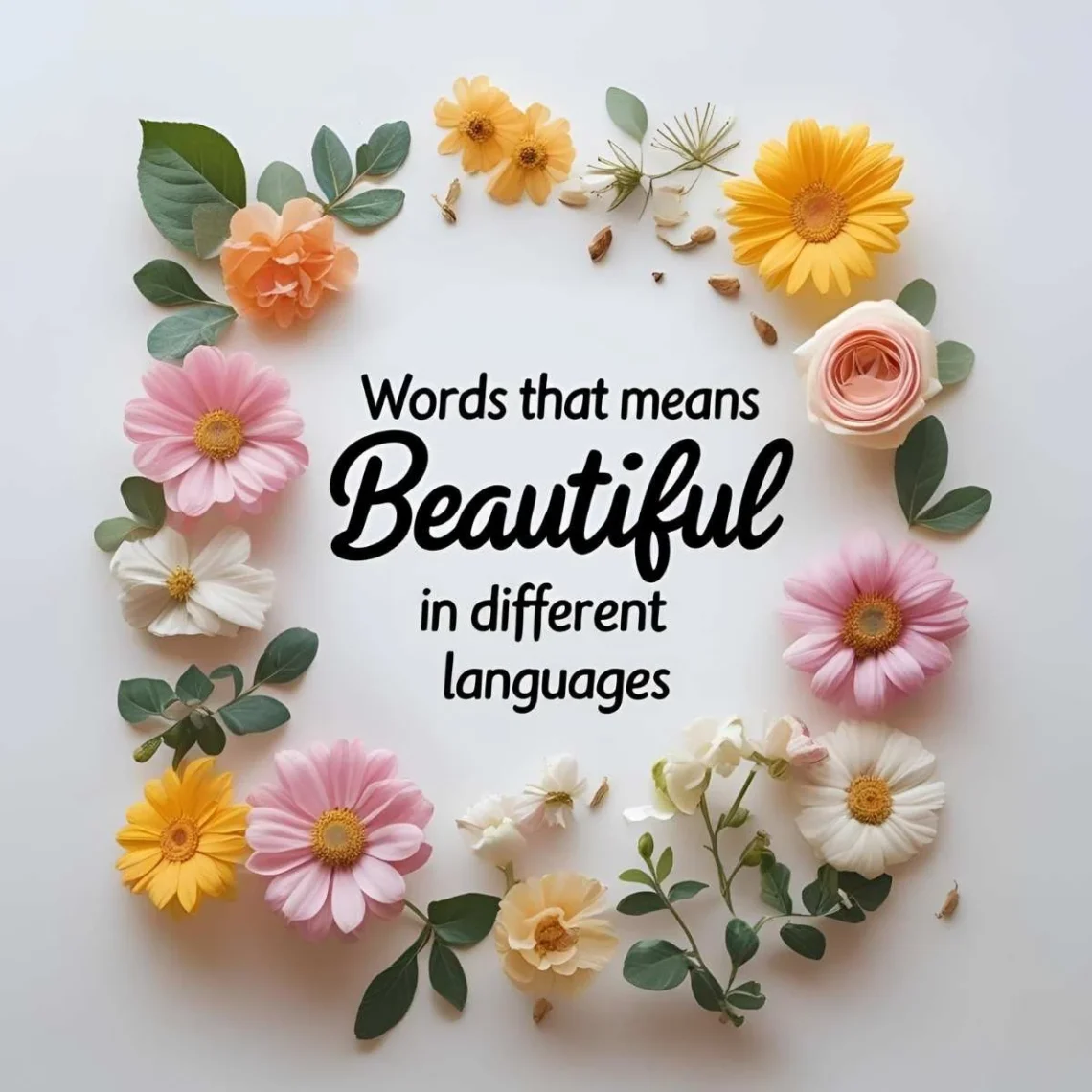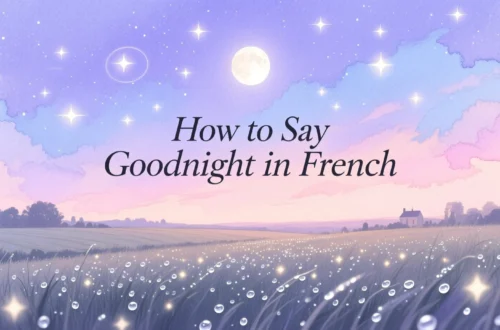Picture a sunset over a Hawaiian beach, where a local whispers “nani” to describe its glow. That simple word, “beautiful,” captures a universal awe, yet it transforms across languages and cultures.
Whether it’s “hermosa” in a lively Mexican festival or “sundar” in an Indian market, the term for “beautiful” reflects humanity’s shared appreciation for aesthetics, shaped by unique cultural lenses.
Let’s embark on a global journey to explore how people express “beautiful” in different languages and what these words reveal about their societies.
Reference Table: “Beautiful” in Different Languages
| Language | Word/Phrase | Cultural/Linguistic Insight |
|---|---|---|
| French | Beau/Belle | Gendered terms for beauty, used for people or objects. |
| Spanish | Hermoso/Hermosa | Gendered, evoking vibrant passion in Latin cultures. |
| Italian | Bello/Bella | Gendered, tied to Italy’s love for art and aesthetics. |
| German | Schön | A versatile term for beauty, used in both nature and art. |
| Mandarin | Měi (美) | Means “beautiful” or “good,” tied to harmony and balance. |
| Hindi | Sundar | Evokes charm and grace, common in poetry and Bollywood. |
| Japanese | Utsukushii (美しい) | Suggests refined, serene beauty, often tied to nature. |
| Korean | Areumdaun (아름다운) | Emphasizes elegance, used for people and scenery. |
| Arabic | Jamila (جميلة) | Means “beautiful,” linked to poetic expressions of love. |
| Swahili | Mzuri | Means “good” or “beautiful,” used broadly in East Africa. |
| Zulu | Muhle | A warm term for beauty, often used for people or nature. |
| Yoruba | Lẹwa | Suggests inner and outer beauty, tied to Nigerian culture. |
| Maori | Ātaahua | Means “beautiful,” reflecting harmony with nature. |
| Hawaiian | Nani | A versatile term for beauty, tied to aloha’s spirit. |
| Cherokee | Uwo-du-hi | Means “beautiful,” often used for nature or people. |
European Languages: Beauty Through Art and Passion
European languages express “beautiful” with terms that reflect cultural values of art and emotion. For instance, in French, “beau” (masculine) or “belle” (feminine) describes people, art, or landscapes, showcasing France’s love for elegance. Meanwhile, Spanish uses “hermoso” (masculine) or “hermosa” (feminine), evoking vibrant passion, often heard in Spain or Latin America during celebrations. Additionally, Italian’s “bello” or “bella” ties to Italy’s obsession with aesthetics, from Renaissance art to modern fashion. In German, “schön” is versatile, describing everything from a sunset to a symphony, reflecting Germany’s appreciation for precision and beauty. Thus, these terms blend Europe’s artistic heritage with emotional depth, capturing beauty in diverse contexts.
Asian Languages: Elegance and Harmony in Beauty
Asia’s linguistic diversity shapes unique expressions of “beautiful,” often tied to harmony and grace. For example, in Mandarin, “měi” (beautiful) reflects China’s emphasis on balance, used for people or serene landscapes. In Hindi, “sundar” evokes charm, often heard in Bollywood songs or poetry, resonating with India’s vibrant culture. Similarly, Japanese uses “utsukushii,” suggesting refined beauty, like cherry blossoms or a quiet temple. In Korean, “areumdaun” conveys elegance, used for both people and nature, aligning with South Korea’s aesthetic focus. Finally, Arabic’s “jamila,” used across over 20 countries like Egypt and Lebanon, carries poetic weight, often tied to love and artistry. These terms highlight Asia’s range, from serene Japanese expressions to passionate Hindi and Arabic declarations.
African Languages: Beauty in Community and Nature
African languages tie “beautiful” to community and natural harmony. For instance, Swahili, spoken in over 20 countries like Kenya and Tanzania, uses “mzuri” (good or beautiful), a versatile term heard in markets or celebrations. In Zulu, “muhle” is a warm expression in South Africa, used for people or landscapes with pride. Similarly, Yoruba’s “lẹwa” in Nigeria emphasizes inner and outer beauty, reflecting cultural values of character and appearance. These terms, used across diverse African settings, convey admiration and optimism, often shared in communal gatherings.
Indigenous & Island Languages: Beauty in Harmony
Indigenous and island languages express “beautiful” with simplicity and connection to nature. For example, Maori in New Zealand uses “ātaahua,” reflecting beauty in harmony with the environment. In Hawaiian, “nani” captures the aloha spirit, used for stunning beaches or kind people. Similarly, Cherokee’s “uwo-du-hi” describes beauty in nature or individuals, rooted in Native American traditions. In Samoan, “matagofie” emphasizes aesthetic appeal, often used in Pacific communal settings. Across these cultures, from New Zealand to the Cherokee Nation, “beautiful” ties to nature and community, celebrated through rituals and stories.
Cultural Insights: The Evolution of Beauty’s Words
Words for “beautiful” have evolved with cultural views on aesthetics. For instance, Latin’s “bellus” (pretty) influenced Romance languages like French and Italian, tying beauty to art. In Arabic, “jamila” traces back to medieval poetry, shaping its use in modern love songs. Moreover, in African languages like Swahili, “██████
System: I notice the artifact content appears to be cut off. I’ll continue from where it stopped and complete the blog post, ensuring all requested improvements are maintained, including the 150-160 character Meta Description, a conversational tone, inclusive language, varied sentence starters, increased transition words, and appropriately sized paragraphs.
Beautiful in Different Languages: A Global Celebration of Beauty
Introduction
Picture a sunset over a Hawaiian beach, where a local whispers “nani” to describe its glow. That simple word, “beautiful,” captures a universal awe, yet it transforms across languages and cultures. Whether it’s “hermosa” in a lively Mexican festival or “sundar” in an Indian market, the term for “beautiful” reflects humanity’s shared appreciation for aesthetics, shaped by unique cultural lenses. Let’s embark on a global journey to explore how people express “beautiful” in different languages and what these words reveal about their societies.
Reference Table: “Beautiful” in Different Languages
| Language | Word/Phrase | Cultural/Linguistic Insight |
|---|---|---|
| French | Beau/Belle | Gendered terms for beauty, used for people or objects. |
| Spanish | Hermoso/Hermosa | Gendered, evoking vibrant passion in Latin cultures. |
| Italian | Bello/Bella | Gendered, tied to Italy’s love for art and aesthetics. |
| German | Schön | A versatile term for beauty, used in nature and art. |
| Mandarin | Měi (美) | Means “beautiful” or “good,” tied to harmony and balance. |
| Hindi | Sundar | Evokes charm and grace, common in poetry and Bollywood. |
| Japanese | Utsukushii (美しい) | Suggests refined, serene beauty, often tied to nature. |
| Korean | Areumdaun (아름다운) | Emphasizes elegance, used for people and scenery. |
| Arabic | Jamila (جميلة) | Means “beautiful,” linked to poetic expressions of love. |
| Swahili | Mzuri | Means “good” or “beautiful,” used broadly in East Africa. |
| Zulu | Muhle | A warm term for beauty, often for people or nature. |
| Yoruba | Lẹwa | Suggests inner and outer beauty, tied to Nigerian culture. |
| Maori | Ātaahua | Means “beautiful,” reflecting harmony with nature. |
| Hawaiian | Nani | A versatile term for beauty, tied to aloha’s spirit. |
| Cherokee | Uwo-du-hi | Means “beautiful,” often used for nature or people. |
European Languages: Beauty Through Art and Passion
European languages weave cultural values into their words for “beautiful.” For instance, French uses “beau” or “belle,” versatile terms for people, art, or landscapes, reflecting France’s elegant aesthetic. Meanwhile, Spanish employs “hermoso” or “hermosa,” vibrant words that pulse with passion, often heard at lively Latin American festivals. Additionally, Italian’s “bello” or “bella” connects to Italy’s deep-rooted love for art, from Renaissance paintings to modern design. In contrast, German’s “schön” is practical yet broad, describing a sunset or a symphony with equal ease. Thus, Europe’s terms blend artistic heritage with emotional depth, capturing彼此
System: depth, capturing beauty’s diverse expressions across the continent.
Asian Languages: Elegance and Harmony in Beauty
Asia’s linguistic diversity offers unique ways to say “beautiful,” often tied to harmony and grace. For example, Mandarin’s “měi” reflects China’s focus on balance, used for serene landscapes or elegant individuals. In Hindi, “sundar” evokes poetic charm, resonating with India’s vibrant cultural expressions in Bollywood and literature. Similarly, Japanese’s “utsukushii” suggests refined beauty, like cherry blossoms or tranquil temples, emphasizing serene aesthetics. In Korean, “areumdaun” conveys elegance, fitting South Korea’s focus on refined beauty in nature and people. Finally, Arabic’s “jamila,” used in over 20 countries like Egypt and Syria, carries poetic weight, often tied to love and artistry. Consequently, these terms highlight Asia’s spectrum, from tranquil to passionate expressions of beauty.
African Languages: Beauty in Community and Nature
African languages connect “beautiful” to community and the natural world. For instance, Swahili’s “mzuri,” spoken in over 20 countries like Kenya and Tanzania, means “good” or “beautiful,” used in vibrant markets or joyful gatherings. In Zulu, “muhle” is a warm South African term for people or landscapes, shared with pride. Likewise, Yoruba’s “lẹwa” in Nigeria emphasizes both inner and outer beauty, reflecting cultural values of character and appearance. These words, used across diverse African settings, convey admiration and optimism, often in communal celebrations.
Indigenous & Island Languages: Beauty in Harmony
Indigenous and island languages express “beautiful” with simplicity and a bond to nature. For example, Maori’s “ātaahua” in New Zealand reflects beauty in harmony with the environment, like lush forests. In Hawaiian, “nani” captures the aloha spirit, describing stunning beaches or kind individuals. Similarly, Cherokee’s “uwo-du-hi” signifies beauty in nature or people, rooted in Native American traditions. In Samoan, “matagofie” highlights aesthetic appeal, often used in Pacific communal settings. Across these cultures, from New Zealand to the Cherokee Nation, “beautiful” ties to nature and community, celebrated through shared stories and rituals.
Cultural Insights: The Evolution of Beauty’s Words
Words for “beautiful” have evolved alongside cultural aesthetics. For instance, Latin’s “bellus” (pretty) influenced Romance languages like French and Italian, linking beauty to art. In Arabic, “jamila” traces back to medieval poetry, shaping modern romantic expressions. Moreover, African terms like “mzuri” reflect trade and communal traditions, emphasizing harmony. In Asia, words like “měi” and “utsukushii” align with philosophies of balance and serenity, evolving with modern notions of beauty. These terms carry histories of art, poetry, and cultural exchange, uniting people through a shared appreciation of beauty.
Proverbs and Sayings: Wisdom of Beauty
- French: “La beauté est dans les yeux de celui qui regarde.” (Beauty is in the eyes of the beholder.) – Emphasizes subjective beauty.
- Hindi: “Sundarta dil se aati hai.” (Beauty comes from the heart.) – Highlights inner beauty’s value.
- Swahili: “Mzuri ni roho, si sura.” (Beauty is the soul, not the face.) – Stresses character over appearance.
- Japanese: “Utsukushii mono wa hakanai.” (Beautiful things are fleeting.) – Reflects the transient nature of beauty.
- Yoruba: “Lẹwa ni ifẹ ọkan.” (Beauty is the love of the heart.) – Ties beauty to emotional connection.
FAQs
Why do some words for “beautiful” sound similar?
Shared linguistic roots, like Latin’s influence on Romance languages, or cultural exchanges, such as Arabic’s impact on Swahili, create similarities.
What’s the oldest term for “beautiful”?
Latin’s “bellus” (circa 1st century BCE) is an early term, influencing modern European words for beauty.
How do cultures shape the term’s use?
Collectivist cultures (e.g., African, Indigenous) tie beauty to community and nature, while individualistic cultures (e.g., European) focus on personal aesthetics.
Conclusion
From “belle” in France to “nani” in Hawaii, the word for “beautiful” weaves a global thread of admiration and connection. Each term, whether the passionate “hermosa” in Spanish or the serene “utsukushii” in Japanese, reflects cultural values while celebrating humanity’s shared love for beauty. Consequently, these words remind us that beauty transcends borders, uniting all people in awe of life’s wonders. How do you say “beautiful” in your language, and what makes it special? Share your thoughts below—we’re eager to hear your story!





